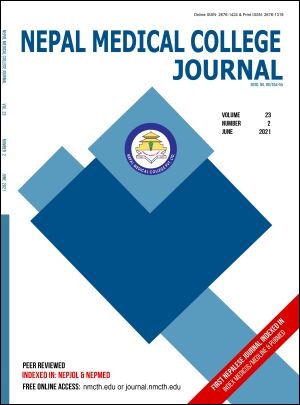Profile of Amblyopia and Outcome of Occlusion Therapy in Amblyopic Patients Attending Tertiary Care Hospital of Kathmandu
DOI:
https://doi.org/10.3126/nmcj.v23i2.38505Keywords:
Amblyopia, Refractive error, occlusion therapy, NepalAbstract
Amblyopia is a common cause of visual impairment in children. The aim of this study was to assess the profile of amblyopia and the outcome of occlusion therapy in amblyopic children attending the eye department of a tertiary care hospital. This was a hospital based prospective interventional study. Sixty-five eyes of 47 patients fulfilling the inclusion criteria were included in the study. Occlusion therapy was started for the diagnosed amblyopic cases after refractive adaptation of 4 weeks. The mean age of presentation was 8.8 ±3.2 years. 29(61.7%) cases had unilateral amblyopia, 18(38.3%) cases had bilateral amblyopia. Ametropic amblyopia (52.3%) was the most common type of amblyopia followed by Anisometropia (23.1%). Refractive error was the most common cause of amblyopia with compound myopic astigmatism seen among 30.8% and hypermetropia among 29.2% of patients. There was no significant association between initial visual acuity with age of presentation and types of amblyopia respectively (P=0.1, P=0.5). The final visual outcome after therapy was better among patients with Ametropic amblyopia than other types (P=0.02). There was significant association between final visual outcome with age, initial visual acuity, type and severity of amblyopia respectively (P<0.001, P<0.001, P=0.02, P=0.02). In conclusion, Ametropia was the most common type of amblyopia. The mean age of presentation was 8.8 years, which was beyond the critical period affecting the outcome of treatment. Uncorrected refractive error was the most common amblyogenic factor. Age of presentation, types and severity of amblyopia are the important contributing factors for the outcome of occlusion therapy. Therefore, early detection and management of amblyopia is important to reduce visual impairment among children.
Downloads
Downloads
Published
How to Cite
Issue
Section
License
Copyright (c) 2021 Nepal Medical College Journal

This work is licensed under a Creative Commons Attribution 4.0 International License.
This license enables reusers to distribute, remix, adapt, and build upon the material in any medium or format, so long as attribution is given to the creator. The license allows for commercial use.




